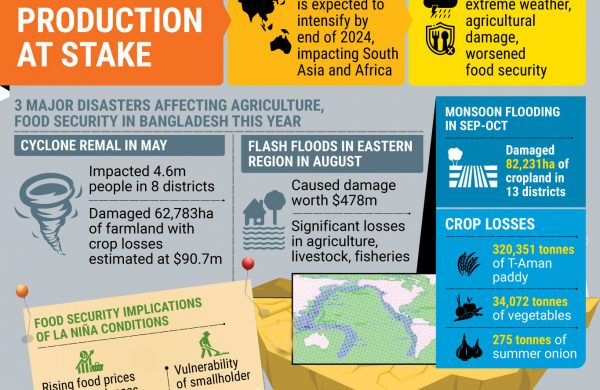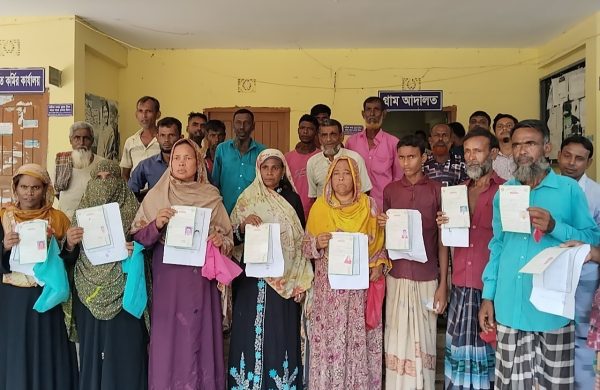Looming La Niña conditions threaten food production
- Update Time : Friday, November 15, 2024

TDS Desk
As Bangladesh grapples with the aftermath of a number of natural disasters in 2024, the emergence of La Niña conditions poses a further threat to the agricultural production and food security of the country along with other South Asian and African nations.
The looming La Niña phenomenon, expected to intensify towards the end of 2024 and persist into early 2025, is likely to bring extreme weather events that could cause extensive agricultural damage and worsen food security, according to a report of the Global Information and Early Warning System on Food and Agriculture (GIEWS) of the Food and Agriculture Organization.
There is particular concern for the areas that are still recovering from the lingering effects of the recent El Niño and are also at risk of La Niña, including parts of East and Southern Africa where acute food insecurity is already at critical levels, says the report.
Dr Mohan Kumar Das, executive director at the National Oceanographic and Maritime Institute (NOAMI) and joint secretary of the South Asian Meteorological Association (SAMA), said, “According to the GIEWS study, La Niña has not been officially declared, yet certain countries are already showing La Niña-like conditions. From late August through September, severe flooding has affected vast regions across West and Central Africa, as well as Sudan, South Sudan, Bangladesh, India, Myanmar, Nepal and Pakistan.”
“In contrast, early indications of drought are emerging in southern South America, notably in Argentina and Chile. FAO remains vigilant in tracking La Niña’s development and any related weather irregularities in the coming months to assess their potential impacts on crop yields and food security,” he said.
Earlier, El Niño caused significant crop losses and disrupted livestock production, leading to food price spikes and reducing the income of households, making them more vulnerable to future weather shocks.
Bangladesh faced four consecutive natural disasters in 2024 from cyclone Remal to eastern floods which severely impacted farmers and food security, particularly in the agriculture, fisheries and livestock sectors.
Cyclone Remal, which battered Bangladesh on 26 May 2024, was one of the most devastating cyclones to hit Bangladesh in recent years, and severely impacted the southern coastal districts of Bangladesh.
The cyclone affected 4.6 million people across eight districts of Pirojpur, Khulna, Bagerhat, Satkhira, Patuakhali, Barguna, Barishal and Bhola, causing widespread damage to over 62,783 hectares of farmland with estimated crop losses of $90.7 million, according to the FAO.
Thousands of farmers lost crops, livestock and access to markets, heightening food insecurity and economic vulnerability in the region.
Only two months later, in August 2024, an unprecedented flash flood hit Bangladesh’s eastern districts of Feni, Noakhali, Cumilla, Khagrachhari and Lakshmipur, further compounding the country’s struggle. The floods caused $478 million in damage to the agriculture, livestock and fisheries sectors, impacting livelihoods, food security and key infrastructure.
The combined losses from these disasters devastated over 191,000 hectares of standing crops, including critical rice production, and created substantial economic losses in the fisheries and livestock sectors. These impacts threatened food security for millions of smallholder farmers and fishers.
From 24 September to 15 October 2024, a total of 82,231 hectares of croplands have been damaged due to heavy rainfall, upstream surge and hilly surge in 13 districts — Mymensingh, Jamalpur, Sherpur, Netrokona, Nilphamari, Chandpur, Lalmonirhat, Kurigram, Rangpur, Gaibandha, Natore, Pabna and Sirajganj, according to the Department of Agricultural Extension.
Around 3,20,351 tonnes of Ropa Aman, 34,072 tonnes of vegetables, 275 tonnes of summer onion and other crops have been damaged during the time.















